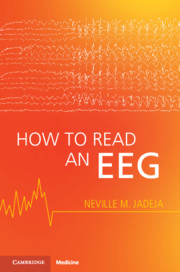Book contents
- How to Read an EEG
- How to Read an EEG
- Copyright page
- Dedication
- Contents
- Figure Contributions
- Foreword
- Preface
- How to Read This Book
- Part I Basics
- Part II Interpretation
- Chapter 9 Approach to EEG Reading
- Chapter 10 Background
- Chapter 11 Foreground (How to Describe an Abnormality)
- Chapter 12 Common Artifacts
- Chapter 13 Normal Variants
- Chapter 14 Sporadic Abnormalities
- Chapter 15 Repetitive Abnormalities
- Chapter 16 Ictal Patterns (Electrographic Seizures)
- Chapter 17 Activation Procedures
- Part III Specific Conditions
- Appendix How to Write a Report
- Index
- References
Chapter 11 - Foreground (How to Describe an Abnormality)
from Part II - Interpretation
Published online by Cambridge University Press: 24 June 2021
- How to Read an EEG
- How to Read an EEG
- Copyright page
- Dedication
- Contents
- Figure Contributions
- Foreword
- Preface
- How to Read This Book
- Part I Basics
- Part II Interpretation
- Chapter 9 Approach to EEG Reading
- Chapter 10 Background
- Chapter 11 Foreground (How to Describe an Abnormality)
- Chapter 12 Common Artifacts
- Chapter 13 Normal Variants
- Chapter 14 Sporadic Abnormalities
- Chapter 15 Repetitive Abnormalities
- Chapter 16 Ictal Patterns (Electrographic Seizures)
- Chapter 17 Activation Procedures
- Part III Specific Conditions
- Appendix How to Write a Report
- Index
- References
Summary
First identify the foreground abnormality (or activity) based on three key features of Location (generalized, lateralized, bilaterally independent, focal, or multifocal), occurrence (sporadic or repetitive), and morphology (sharp or blunt). Next, qualify your description with the modifiers of prevalence, duration, amplitude, and frequency. Prevalence - abnormalities may be continuous or intermittent, if intermittent; they may be abundant, frequent, occasional or rare. Duration - intermittent abnormalities may be very long, long, intermittent, brief, or of a very brief duration when they occur. These terms are most useful with continuous EEG monitoring. Amplitude - abnormalities may be very low (< 20 uV), low (20-49 uV), medium (50-199 uV), or high (> 200 uV) in amplitude; always measure the absolute amplitude (peak to trough). Frequency - measure the typical rate of the abnormality to the nearest 0.5 per second division. When reporting the waveform, the modifiers (prevalence, duration, amplitude, and frequency) should precede the three key features of location, composition, and morphology.
- Type
- Chapter
- Information
- How to Read an EEG , pp. 79 - 82Publisher: Cambridge University PressPrint publication year: 2021

